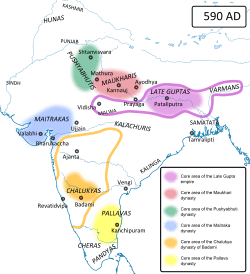Maukhari
| Maukhari Empire | ||||||||
| ||||||||
 Maukharis and their contemporaries in India | ||||||||
| Capital | Kannauj | |||||||
| Languages | Sanskrit | |||||||
| Religion | Hinduism Buddhism | |||||||
| Government | Monarchy | |||||||
| Maharajadhirajas | Yagna Varman | |||||||
| Isana Varman | ||||||||
| Historical era | Classical India | |||||||
| • | Established | CE 550s | ||||||
| • | Disestablished | 8th century | ||||||
| ||||||||
The Maukhari Dynasty was a royal Indian dynasty that controlled vast areas of Northern India for over six generations. They earlier served as vassals of the Guptas as well as related to Harsha and his short-lived Vardhan dynasty. The Maukharis established their independence at Kannauj, during the 6th century. The dynasty ruled over much of Uttar Pradesh and Magadha. Around 606 CE, a large area of their empire was reconquered by the Later Guptas.[1]
Rulers
The known Maukhari rulers of madhya-desha include:[2]
- Hari-varman
- Aditya-varman
- Ishvara-varman (Iśvaravarman)
- Ishana-varman (Iśanavarman), r. c. 550-560 CE
- Sharva-varman (Śarvavarman), r. c. 560-575 CE
- Anti-varman, r. c. 575-600 CE
- Graha-varman, r. c. 600-675 CE
See also
References
- ↑ "Maukhari dynasty (Indian dynasty) - Britannica Online Encyclopedia". Britannica.com. Retrieved 2013-01-26.
- ↑ Ronald M. Davidson 2012, p. 34-35.
Bibliography
- Ronald M. Davidson (2012). Indian Esoteric Buddhism: A Social History of the Tantric Movement. Columbia University Press. ISBN 9780231501026.
External links
- Joseph Schwartzberg. The Historical Atlas of South Asia. Map of the “Age of Pusyabhutis & Calukyans, c. A.D. 550-700”. (Pg 26).
This article is issued from Wikipedia - version of the 10/17/2016. The text is available under the Creative Commons Attribution/Share Alike but additional terms may apply for the media files.